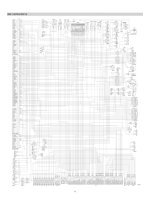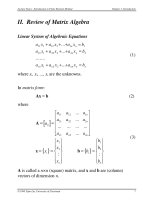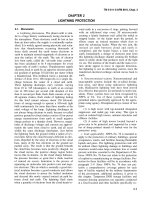Chapter 2: ELECTRONIC & STERIC EFFECTS pps
Bạn đang xem bản rút gọn của tài liệu. Xem và tải ngay bản đầy đủ của tài liệu tại đây (648.39 KB, 40 trang )
1
ORGANIC CHEMISTRY
Dr Nam T. S. Phan
Faculty of Chemical Engineering
HCMC University of Technology
Office: room 211, B2 Building
Phone: 8647256 ext. 5681
Email:
2
Chapter 2: ELECTRONIC &
STERIC EFFECTS
Conjugation / Mesomeric
Steric
Electronic
Inductive
Hyperconjugation
Effects
3
INDUCTIVE EFFECTS (I)
C-C σ bond in butane:
almost completely nonpolar
δ-
δ+
δ'+
δ''+
δ'''+
C-C σ bond in 1-
fluorobutane: polarized
C1 is more positive than C2 as a result of electron-
attracting ability of F
4
The more electronegative
the X, the stronger the –I
effect
5
The more electropositive the Z, the stronger
the +I effect
6
-I
-I
Through a period in a periodic table
Through a
group in a
periodic
table
7
K
a
.10
5
CH
3
CH
2
CH
2
COOH 1.5
CH
3
CH
2
CH(Cl)COOH 139
CH
3
CH(Cl)CH
2
COOH 8.9
ClCH
2
CH
2
CH
2
COOH 3.0
Strong -I
weak -I
8
CONJUGATION / MESOMERIC
EFFECTS (C / M)
Electron delocalization in a conjugated system:
Alternating
single &
multiple
bonds
9
O is more electronegative than C
Electrons move through π-bond network towards C=O
The conjugated system is polarized
C=O has negative conjugation / mesomeric effect (-
C / -M) on the conjugated system
10
+C
-C
C CH
CH
CH
CHR
+C-C
C O R
CH
CH
CH
CH
R
O R
+C
-C
11
OH
+C
-C
O H
-C
+C
NH
2
+C
-C
-C
+C
N
12
-C groups generally contain an electronegative atom (s)
or / and a π-bond (s):
CHO, C(O)R, COOH, COOR, NO
2
, CN, aromatics, alkenes
Cl, Br, OH, OR, SH, SR, NH
2
, NHR, NR
2
, aromatics, alkenes
+C groups generally contain a lone pair of electrons
or a π-bond (s):
Aromatics or alkenes can be both +C and-C
13
+C
Through a period in a periodic table
Through a
group in a
periodic
table
+C
14
CH
CH
CH
CH
H
C
H CH
CH
C
CH
CH
CH
CH
CH
C
CH
H
O
H
H
O
H
O
INDUCTIVE vs CONJUGATION
EFFECTS
Mobility of hydrogen
atoms: almost the same
-C
15
INDUCTIVE vs CONJUGATION
EFFECTS
•
C effects are generally stronger than I
effects
•
C effects can be effective over much
longer distances than I effects –
provided that conjugation is present
•
I effects are determined by distance, C
effects are determined by relative
positions
16
HYPERCONJUGATION EFFECTS (H)
Electron density from Cα-H flows into the vacant p orbital
(in carbocation / C=C / C
≡
C) because orbitals can partially
overlap
Hyperconjugation effects (H)
17
H C
H
H
CH
CH
CH
2
CH
3
δ+
δ−
HCl
CH
3
CH
Cl
CH
2
CH
2
CH
3
•
H effect of -CH
3
is stronger than H effect of -CH
2
-
•
H effect is generally stronger than I effect
Electron-donating ability of -CH
3
is stronger
than that of -CH
2
CH
3
18
STERIC EFFECTS
•
A steric effect is an effect on relative rates caused
by space-filling properties of those parts of a
molecule attached at / near the reacting site
•
Steric hindrance: the spatial arrangement of the
atoms / groups at / near the reacting site hinders /
retards a reaction
•
Generally, very large & bulky groups can hinder
the formation of the required transition state
19
Steric hindrance
20
Steric
hindrance
21
ACIDITY & BASICITY
22
23
Electron-
donating
groups
Electron-
withdrawing
groups
24
Electron-
donating
groups
Electron-
withdrawing
groups
25
If –C groups are introduced at ortho- & para
position on phenol rings:
+ The anion (-O
-
) can be further stabilized by
delocalization through the conjugated system as
the negative charge can be spread onto the -C
groups
+ The O-H bond is more polarized as electron
density on –OH can be spread onto the -C groups
Acidity of phenols is generally increased









